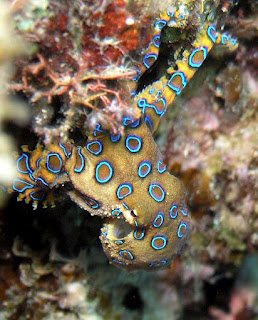 |
| Hapalochlaena lunulata |
The Greater Blue-ringed Octopus is distinctive among its family members in that it has a relatively large range. Most others live in a very specific watery area, but the Great Blue-ringed can be found in tropical waters throughout the Pacific Ocean, and in parts of the Indian Ocean as well.
These Octopuses get their names from the bright blue circles that appear when they feel threatened. I should note that these rings are visible during calm periods as well, but they are much less noticeable. Those vibrant patches serve as warnings to predators because these guys are venomous! Greater Blue-ringed Octopuses actually have two types of venom-- one that they use to deter would-be attackers, and one that they themselves use to attack prey (small little invertebrates and fish).
Great Blue-ringed Octopus venom can be incredibly dangerous to humans. They don't usually attack unprovoked, but if you do something to make them feel threatened, watch out! The toxin paralyzes and can kill in a matter of minutes!
IUCN Status : Not Listed
Location : Tropical Pacific Ocean
Size : Body length up to 5cm
Classification : Phylum : Mollusca -- Class : Cephalopoda -- Order : Octopoda
Family : Octopodidae -- Genus : Hapalochlaena -- Species : H. lunulata
Family : Octopodidae -- Genus : Hapalochlaena -- Species : H. lunulata
Comments
Post a Comment